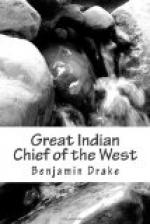From the treaty of peace, between the United States and the Sac Indians of Rock river, in 1816, to the commencement of hostilities between these parties in 1832, the life of Black Hawk seems to have been quiet and monotonous, occasionally relieved by a warlike excursion, but generally spent in hunting, throughout the winter, and in loitering about his village, during the summer. Such, indeed, is the life of most Indians. Having no intellectual pursuits and little desire for the acquisition of property, beyond the supply of their immediate wants, they have in reality but two sources of excitement—war and the chase. They take no interest in the domestic affairs of their families, have little taste for the pursuits of agriculture, and, if not engaged in hostile excursions, in following the deer, or in trapping the beaver, they sink into listless inactivity. It is highly probable that many of their wars are undertaken, more for the gratification of that love of excitement, which is an indestructible element of the human mind, than from any constitutional proneness to cruelty and bloodshed. They need both physical and intellectual excitation, and having none of the resources which mental and moral culture throws open to civilized man, they seek it in making war upon each other or upon the wild animals which share with them the woods and the prairies.
Subsequently to the treaty of 1816, and perhaps in that year, the government of the United States built Fort Armstrong, upon Rock Island, in the Mississippi river, and but a few miles from the village where Black Hawk and his band resided. This measure, though not actually opposed, was by no means acceptable to them. They probably did not relish the gradual advances upon them, of the white population; but they entertained, moreover, a special regard for this beautiful island, which is justly considered one of the finest in the whole extent of the Mississippi. It is fertile, and produces many varieties of nuts and fruits, and being in the rapids of the stream, the waters which lave its shores, yield an abundance of excellent fish. In addition to all this, they have a traditionary belief, that the island was the favorite residence of a good spirit which dwelt in a cave in the rocks on which Fort Armstrong now stands. This spirit had often been seen by the Indians, but after the erection of the Fort, alarmed by the noise and intrusion of the white man, it spread its beautiful, swan-like wings, and disappeared. During the year 1817, the Sacs sent out some warriors against the Sioux, and succeeded in killing several of them, but Black Hawk was not of the party. About this time, his eldest son sickened and died, and within a short period afterwards, he lost his youngest daughter. This affliction seems to have made a deep impression upon him; and according to a custom common among the Indians, he blacked his face, and for the ensuing two years lived at home, in seclusion, drinking water at mid-day,




